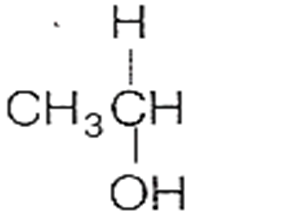 Multiple Choice Questions
Multiple Choice QuestionsClemmensen reduction of a ketone is carried out in the presence of which of the following?
Zn-Hg with HCl
LiAlH4
H2 and Pt as catalyst
Glycol with KOH
Which one of the following does not undergo iodoform reaction?
Secondary butyl alcohol
Iso-propyl alcohol
Diethyl ketone
Ethyl alcohol
C.
Diethyl ketone
lodoform reaction is given by only those compounds that have either CH3- CH = O or CH3-CH2-OH group.
a. ![]() (sec- butyl alcohol gives iodoform reaction)
(sec- butyl alcohol gives iodoform reaction)
b. ![]() (ios- propyl alcohol gives iodoform reaction)
(ios- propyl alcohol gives iodoform reaction)
c. ![]() (diethyl ketone. It does not give iodoform reaction.)
(diethyl ketone. It does not give iodoform reaction.)
d.  ethyl alcohol (gives iodoform reaction)
ethyl alcohol (gives iodoform reaction)
In electrophilic aromatic substitution reaction, the nitro group is meta directing because it
decreases electron density at ortho and para positions
decreases electron density at meta position
increases electron density at meta position
ncreases electron density at ortho and para positions
The compound which is not formed during the dry distillation of a mixture of calcium formate and calcium acetate is
methanal
propanal
propanone
ethanal
The compound which forms acetaldehyde when heated with dilute NaOH, is
1,1-dichloroethane
1,1,1-trichloroethane
1-chloroethane
1,2-dichloroethane
Which of the following reagents converts both acetaldehyde and acetone to alkanes ?
Ni/H2
LiAlH4
I2/ NaOH
Zn-Hg/ conc. HCl
The reaction,
C6H5CHO + CH3COOC2H5 C6H5CH = CHCOOC2H5 , is called
Benzoin condensation
Claisen condensation
Cannizaro's reaction
Perkin reaction
